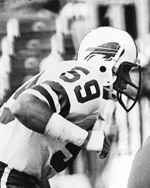Buffalo's "Bermuda Triangle"
 |
|
Fred Smerlas |
The Buffalo Bills were undergoing a transition in the late 1970s. Chuck Knox was hired as head coach in 1978 in hopes of leading the once proud franchise back to respectability. The team had not won a division title since its AFL days that were capped by back-to-back league titles in the mid ‘60s.
One of the first courses of action for Knox was to implement the “3-4” defense for Buffalo. Playing a pivotal role in the new defensive alignment was the nose tackle and two inside linebackers. The blue print for the defensive scheme was put into place with two second round selections in the 1979 NFL Draft. The Bills chose nose tackle Fred Smerlas from Boston College with the 32nd pick overall and then grabbed linebacker Jim Haslett from little Indiana (PA) University with the 51st pick.
 |
|
Shane Nelson |
Both Haslett, the former head coach of the St. Louis Rams and New Orleans Saints, and Smerlas were instant successes on the NFL gridiron. Smerlas accumulated 57 tackles during his rookie campaign. He also had a team-high three fumble recoveries, one of which he returned for a touchdown.
In his first game as a pro, Haslett made 17 tackles as Buffalo battled division rival Miami. He started all 16 games that year and was named the NFL's Defensive Rookie of the Year.
The third cog in the middle of the Bills’ defense was veteran linebacker Shane Nelson, an undrafted free agent from Baylor, who joined Buffalo two seasons earlier.
 |
|
Jim Haslett |
The trio quickly became known as the “Bermuda Triangle” because runners could enter their territory but never made it out! The unit helped the Bills to an improved record in 1979 but made a huge hurdle in 1980.
That season, the team finished 11-5-0 to capture its first division title since 1966. Leading the way was Haslett who recorded a team-high 143 tackles, including 79 solo, two interceptions, and a pair of sacks. Smerlas earned All-Pro and Pro Bowl recognition at nose tackle as he registered 6½ sacks. Nelson contributed 126 tackles, one sack, two fumble recoveries, and a forced fumble.
Buffalo had the top-ranked defense in 1980 as it held opponents to a stingy 256 yards per game. The defense continued to excel the following two seasons (finished No. 7 in 1981 and No. 2 in 1982 in fewest yards allowed) before Knox left the team. Right in the middle of the dominant defense was the “Bermuda Triangle” that thrilled Bills fans and scared opponents’ offenses.
A game of inches
Goal post affects outcome of 1945 NFL title game.
Program cover from Grange's debut
This is the game program from the Chicago Bears Thanskgiving Day game against the cross-town rival Chicago Cardinals. Just 10 days after playing his last game at the University of Illinois, the nation's top collegiate football player Harold "Red" Grange made his NFL debut with the Bears.